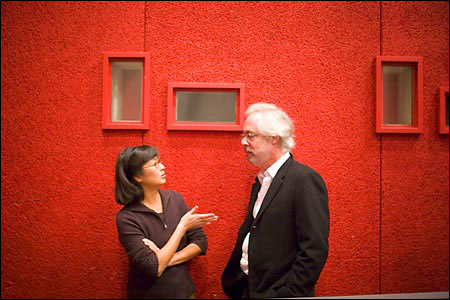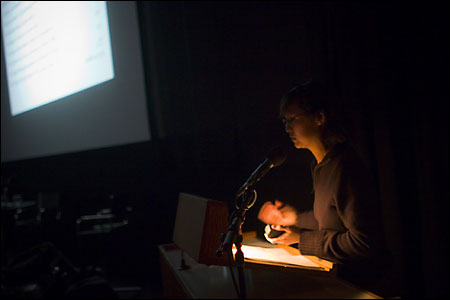Lin’s work ethic daunts and amazes
Sculptor talks about 25 years of accomplishment

What’s Maya Lin been up to since she won a national competition with her design for the Washington, D.C., Vietnam Veterans Memorial Wall when she was a 21-year-old senior at Yale?
Plenty. Audience members at the Carpenter Center got to hear about her past 25 years of activity when she gave a slide lecture there Dec. 1 and engaged in a conversation with Louis Menand, the Anne T. and Robert M. Bass Professor of English and American Literature and Language. The talk was sponsored by the Department of Visual and Environmental Studies.
Lin, now an astonishingly youthful 46, has wasted little time moving beyond her early fame. Nor has she limited herself to the genre in which she first gained notoriety. Her work has included two more notable memorials, whose design encourages the same sort of tactile, interactive responses that have characterized the Vietnam Memorial – the Civil Rights Memorial in Montgomery, Ala., and the Women’s Table, commemorating the admission of female students to Yale.

But she has also designed houses, apartments, landscape architecture, public art, sculpture, gallery installations, a library, a museum, a line of furniture, a skating rink, clothing, two chapels, and a bakery.
Menand acknowledged Lin’s dedication and work ethic in his introductory remarks, calling her a hero for two reasons. First, he praised her gutsy determination to make sure the Vietnam Memorial got built the way she conceived it, which meant having “to stand up to the brass and the suits.”
Second, he praised her because “she never cashed in on her celebrity. She could have appeared in endless television interviews as an expert on war memorials and dealing with grief and loss. But instead, she decided to keep her head down and make some art. How many people in her shoes would have done that?”
Lin’s output has been so voluminous that when she whipped through dozens of slides of her work, commenting on them in her understated Midwestern voice, you almost wanted to shout out for her to slow down so that you could linger over the details of what were obviously some extremely interesting and beautiful projects.
There was the Langston Hughes Library designed for the Children’s Defense Fund’s Haley Farm in Clinton, Tenn., in which she inserted a modern, high-tech skin inside an antique barn. She also designed an interfaith chapel in the same location in the shape of an ark.
There was “11-Minute Line,” a squiggle that has been transformed into a monumental piece of earth art in a cow pasture in Sweden; an outdoor installation for her hometown of Athens, Ohio, for which she collaborated with her brother, poet Tan Lin; a hanging wire installation reproducing the terrain of the ocean bottom near Antarctica; another terrain-based installation constructed of upended two-by-fours; and the Lewis and Clark “Confluence Project” for the state of Washington.
Lin said a project commemorating Lewis and Clark’s “Voyage of Discovery” initially held no interest for her.
“It wasn’t undiscovered land they were exploring. It was home to many different peoples,” she said.
But her attitude changed when a group representing the area’s Indian tribes specifically requested her participation. Working with tribal elders, Lin is developing designs for seven different sites along the route Lewis and Clark followed as they approached the Pacific Ocean.
The sites include an overlook platform at Cape Disappointment, the spot where Lewis and Clark first set eyes on the Pacific; Sacajawea State Park at the confluence of the Snake and Columbia rivers; and a totem circle made of salvaged cedar logs, the sacred wood of the Pacific coastal tribes.
The sites combine words and imagery drawn from the Lewis and Clark journals, Native American myths and stories, and the natural history of the area’s flora and fauna. Lin, who obtained a guarantee from Washington state officials that there would be no censorship of the project’s content, plans to focus on environmental destruction and the breaking of treaties with Indian tribes in some of the installations.
In her conversation with Menand, Lin spoke about her influences, working methods, and philosophy. Her parents fled China when the communists took over, and they settled in southeastern Ohio, in the foothills of the Appalachians. Both taught at the University of Ohio, her father in the fine arts department, her mother in literature. Although Lin does not speak Chinese and grew up hearing little about her parents’ earlier lives, Lin said that being a Chinese American has had an impact on her work.
“I have an attraction to ambivalence. It comes from being of two heritages, having a dual identity.”
Lin’s latest project is designing a new and larger space for the Museum of Chinese in the Americas, based in New York City.
Another influence was the hilly terrain in which she grew up and the monumental earthworks left there by the area’s prehistoric Indian tribes. These experiences and the later influence of earth artists like Robert Smithson, Michael Heizer, and James Turrell, gave her a predilection for works that are embedded into the landscape.
Lin said that science has also been an important component of her work. Starting out in college as a biology major, until she realized vivisection would be part of the curriculum, Lin has continued to borrow from science and technology in her artwork.
“My work is all about revealing something that you may not have known,” she said. “I tend to take information and focus you and make you see it in a different way.”
But how Lin goes about achieving this objective is rarely straightforward.
“I try to tweak your perception. I’m interested in the peripheral. There are times when you’ll walk right by my work and not notice it.”




